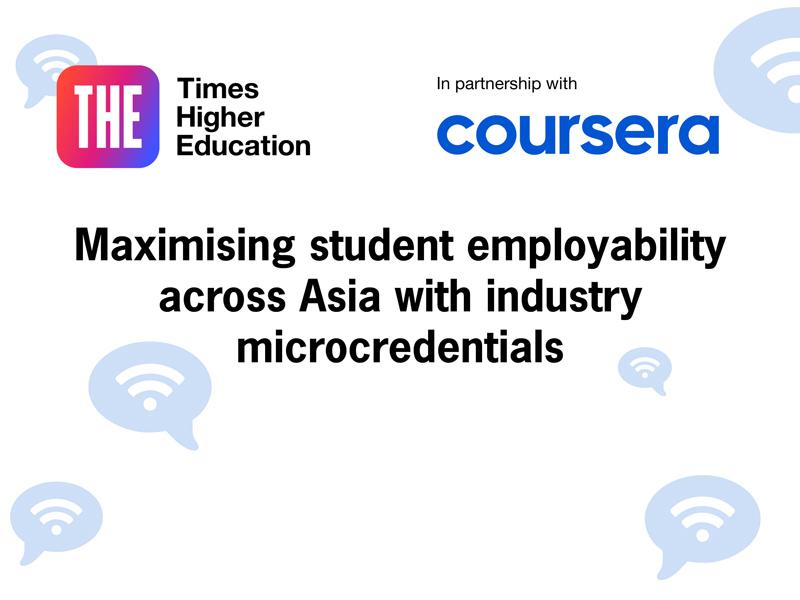The concept of microcredentials falls under the wider umbrella of alternative credentials at Monterrey Institute of Technology. Depending on their duration, alternative credentials are generally classified as either macrocredentials or microcredentials.
Such alternative credentials have gained great momentum in the fields of education and work in recent years, with many experts suggesting we are entering an era in which we no longer speak only of professional degrees but also alternative credentials when evaluating candidates. These credentials allow individuals to demonstrate specialised expertise to employers, showcasing mastery of specific skills and/or competencies – they can be incredibly diverse with respect to their scope, status and purpose.
- Resource collection: The business of online education
- Three steps to developing useful microcredentials
- THE podcast: the big ideas behind microcredentials
Equally, a microcredential is usually a record of focused learning achievements. It should verify what a person knows or can do, include an assessment based on clearly defined quality standards, be attained in a shorter timeframe than a degree and should be granted by a trusted provider, which can be commercial entities, educational and training providers, professional bodies and more. It should hold independent value but also be able to contribute to or complement other microcredentials or macrocredentials.
If you are looking to offer microcredentials at your institution, we suggest considering the following four steps:
1. Planning
The goal of planning is to gather all the necessary information for the foundation of the microcredential, ensuring its success in terms of offer and operation. It should include the following aspects, which must be authorised by the entity responsible for the programme:
Value research: This stage establishes the significance of creating the microcredential, ensuring its value to employers and its relevance to the target audience. Key actions include identifying and analysing competencies aligned with current labour market needs and defining which competencies will be recognised through the microcredential/s.
Creating a business model that encompasses content design, management, operations, administration, costs and dissemination.
2. Design
In this step, it’s essential to establish clear and precise criteria for awarding the microcredential. This involves determining indicators or artefacts to measure students’ competency and achievement levels. It’s also necessary to determine roles that will perform different functions in the process. To achieve this, it’s important to consider:
Defining the didactic model in which the skills or competencies demonstrated through the microcredential are established, the type of formative experience to be designed, the criteria and evaluation standards, whether it will be independent or part of a higher-value credential (stackable). You should also consider at this stage the academic value it will hold, that is, whether its accreditation grants the student an academic credit that can be used in another educational programme.
Integrating and defining the different roles responsible for implementing the microcredential/s. These would likely include: subject matter experts for developing defined content; evaluators to review and validate the students’ artefacts; advisers to support students in achieving the microcredential, who could be part of the evaluator or subject matter expert groups; programme managers to assist students in resolving operational and issuance-related queries.
3. Dissemination and delivery
Once the design of the formative experience, the didactic model and the evaluation criteria are in place, it’s important to design a dissemination plan that ensures the target audience becomes aware of the microcredential offerings, the added value it provides to their profiles, costs, duration, and ways to obtain it, as well as the criteria and evaluation process that will enable them to successfully attain the credential.
It’s also recommended to raise awareness among employers about the value of your microcredentials, which will be issued by the institution. Plus, in order to deliver the microcredential to students, it’s necessary to establish and configure the necessary information structure (courses, competencies, skills, participant data, credits, etc) to issue and support the credential.
In addition, the information to be contained in the document representing the credential, whether electronic or physical (or both), must be defined. This information may include data such as the student’s name, description of the microcredential, validated competencies, level of achievement and an expiration date (if applicable). It’s recommended that this information is represented through both a badge and an electronically validated document issued by the institution. This badge serves as a recognisable and verifiable symbol that the student can share on social networks and in their resume.
Possible platforms for delivering credentials include: Accredible, Credly, and Canvas Credential.
4. Impact measurement
Once the microcredentials have been issued to a certain number of participants, it’s advisable to measure their impact by collecting data on student participation, completion rates, acceptance of the microcredentials in the labour market, etc. This data will enable improvements in future microcredentials offered to students.
In conclusion, having a methodology to develop alternative credentials will help ensure their quality, proper design and delivery management, as well as greater acceptance and recognition in the labour market and among involved parties.
Verónica Alejandra Pérez Aguirre is innovative education leader; Laura Patricia Aldape is director of learning experience innovation; and Karla Margarita Banda Martínez is solution design leader, all at Monterrey Institute of Technology, Mexico.
If you would like advice and insight from academics and university staff delivered direct to your inbox each week, sign up for the Campus newsletter.




comment